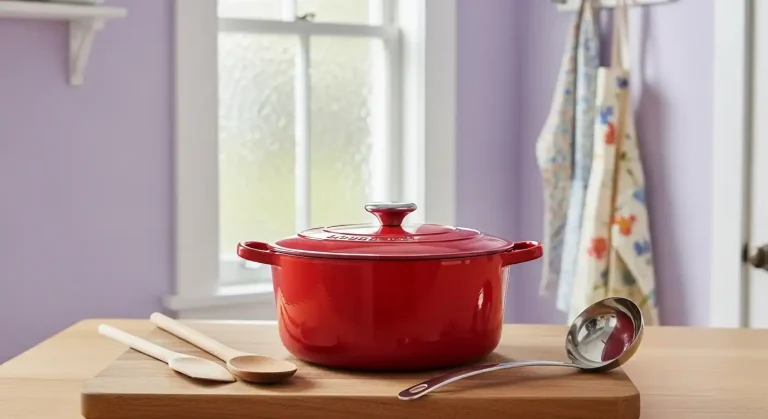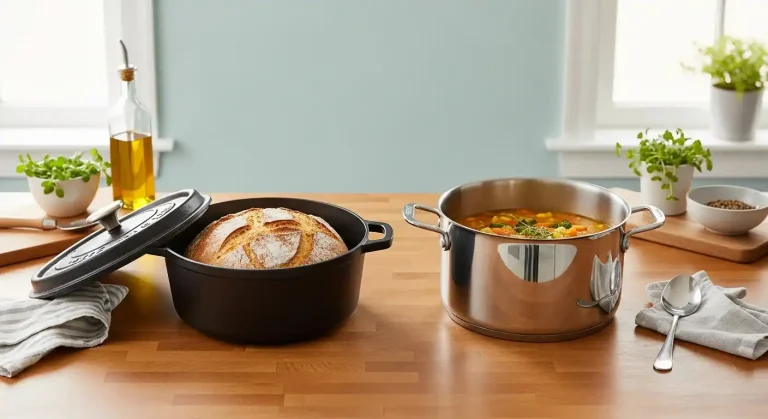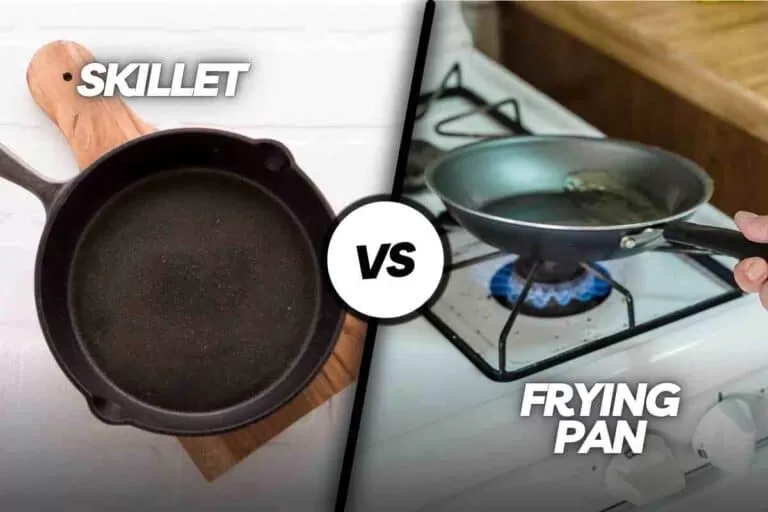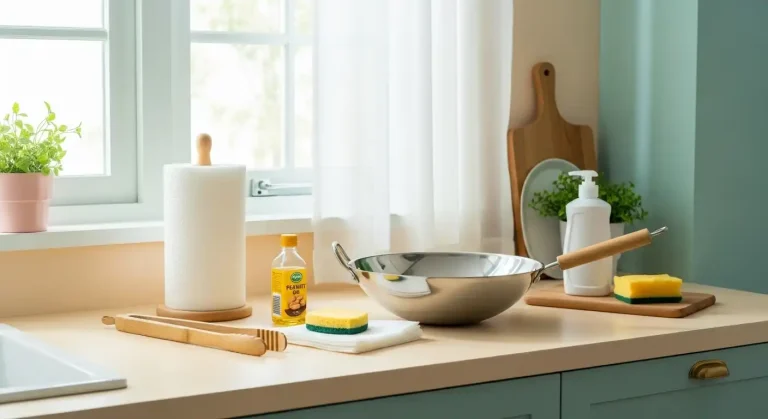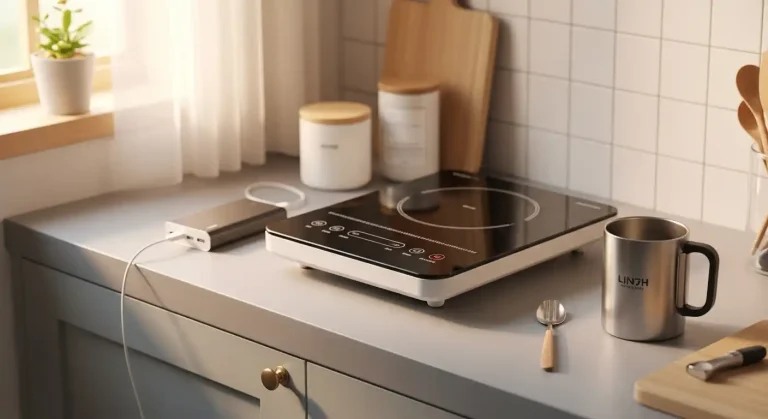Wok Vs Cast Iron Skillet: Which One Deserves a Spot in Your Kitchen?
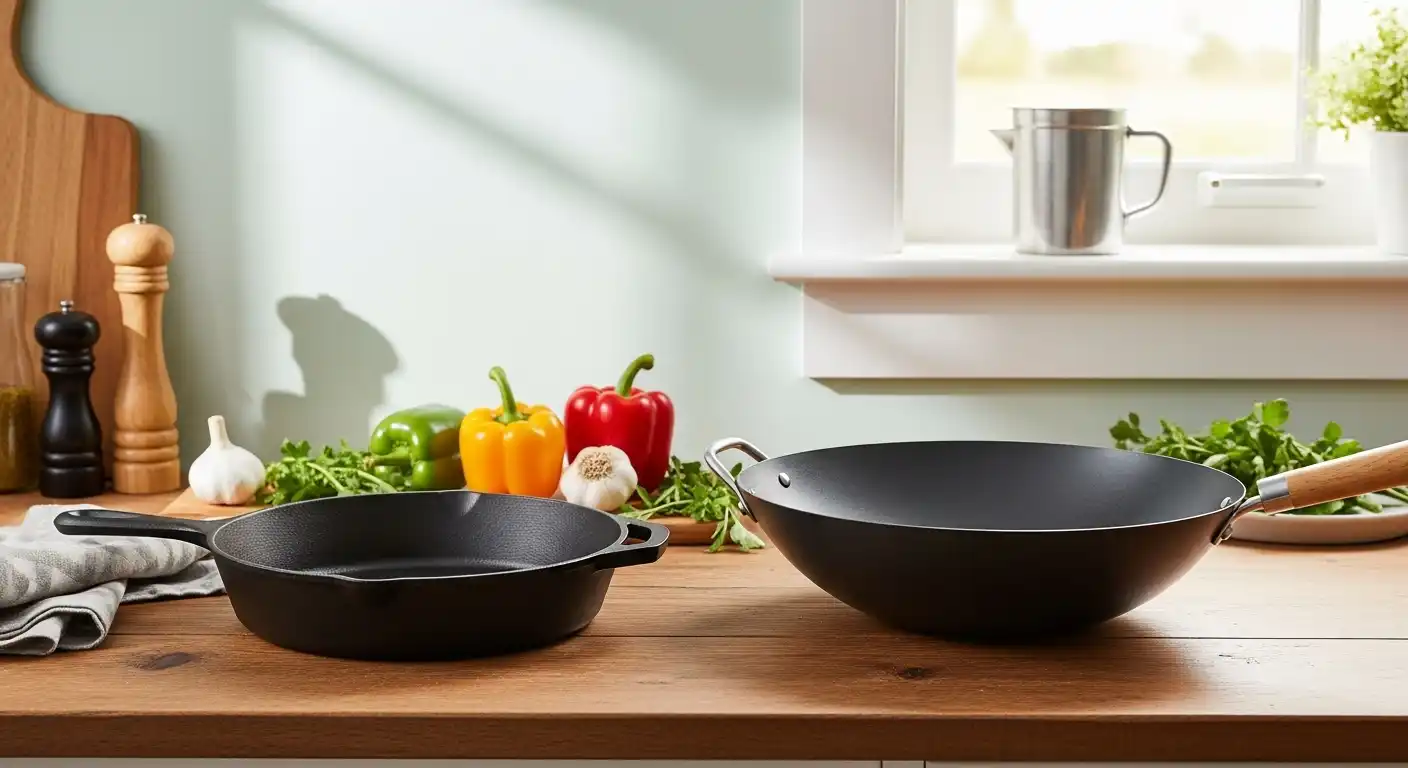
When it comes to versatile cookware, few pieces spark as much debate as the wok vs cast iron skillet.
Both are kitchen staples, each with unique strengths, loyal fan bases, and centuries of culinary tradition behind them.
But if you’re wondering which one deserves a spot on your stove, we’ve got you covered.
Let’s explore the key differences, benefits, and best use cases for these two timeless cooking tools.
🎄 Christmas & Year-End Amazon Deals !
Don’t miss out on the best discounts and top-rated products available right now!
*As an Amazon Associate, I earn from qualifying purchases.
What Makes a Wok So Special?
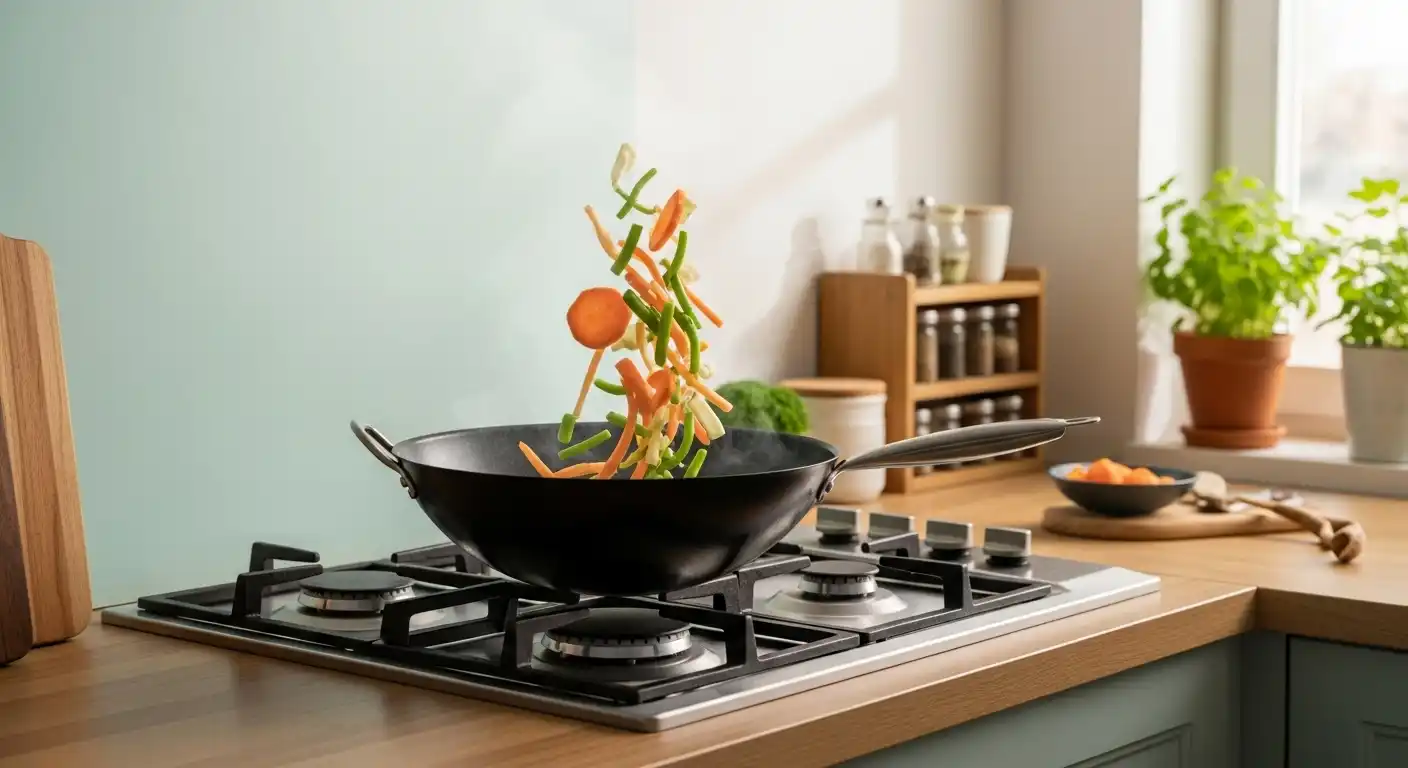
The wok, with its distinct bowl shape and sloping sides, originated in China over 2,000 years ago.
It’s designed for high-heat, quick cooking methods like stir-frying, but its talents don’t stop there.
A carbon steel wok, the most traditional variety, heats up quickly and evenly.
Once seasoned properly, it develops a naturally non-stick surface perfect for searing meat, tossing veggies, or even making popcorn.
Yes, popcorn in a wok is a thing—learn how to make it here.
And the best part? Woks aren’t limited to stir-frying. You can also steam, deep fry, and smoke food in a wok, making it a truly versatile piece of cookware.
If you’re curious whether you can deep fry in a wok, check out our full guide on deep frying with a wok.
Pros of Using a Wok
- Fast heating for quick cooking
- Large surface area for tossing ingredients
- Lightweight (especially carbon steel woks)
- Multi-purpose (steam, fry, boil, smoke)
Cons of a Wok
- Requires seasoning and maintenance
- Can be unstable on flat cooktops without a wok ring (how to use a wok ring on electric stoves)
- Might not heat evenly on certain stovetops without adjustments
Why Cast Iron Skillets Stand the Test of Time
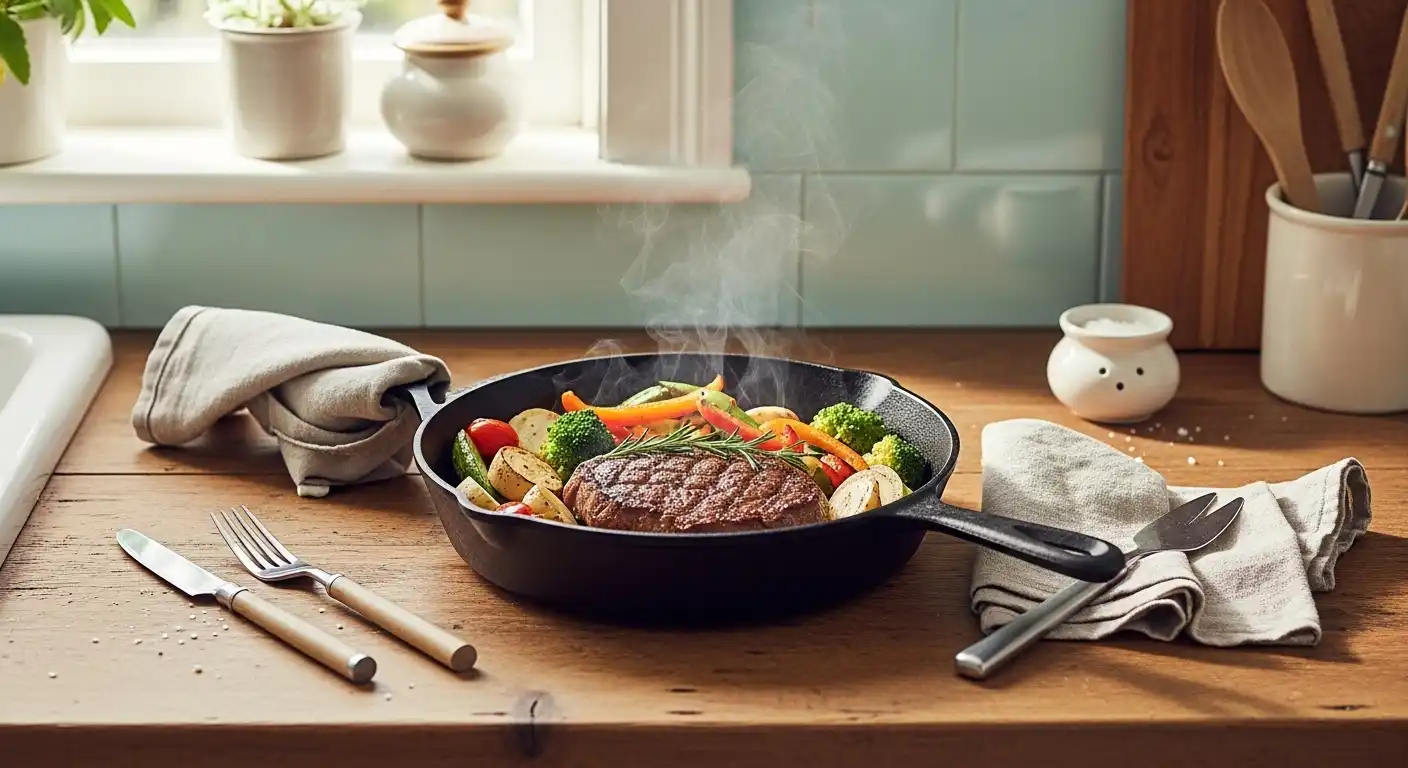
On the other side of the kitchen, the cast iron skillet has its own legions of fans.
With roots tracing back to 18th-century Europe, the cast iron skillet is beloved for its even heat retention and incredible durability.
Unlike a wok, cast iron skillets are flat-bottomed and thick-walled, perfect for low-and-slow cooking as well as high-heat searing.
They’re ideal for recipes where consistent heat is key—think cornbread, pan-seared steaks, and oven-roasted veggies.
And yes, most cast iron skillets can go directly from stovetop to oven (learn more about oven use here).
Pros of a Cast Iron Skillet
- Superior heat retention
- Perfect for searing and baking
- Extremely durable—often lasting generations
- Develops a natural non-stick layer with seasoning
Cons of a Cast Iron Skillet
- Heavy and can be cumbersome for some users
- Requires regular seasoning to prevent rust
- Can take longer to heat up compared to lighter cookware
- Not dishwasher-safe
Cooking Techniques: Wok Vs Cast Iron Skillet in Action
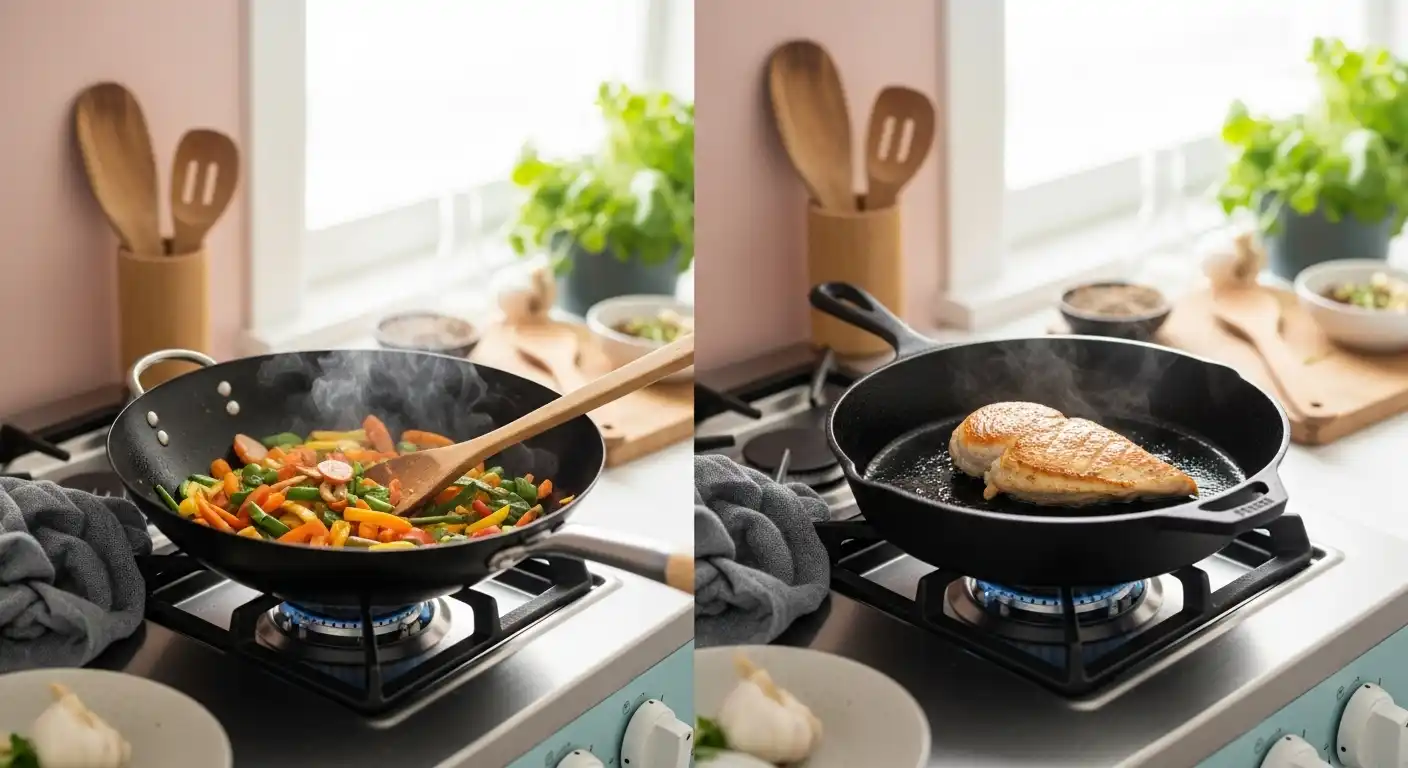
So how do these two pans perform with popular cooking techniques?
Stir-Frying
A wok wins hands down. Its shape allows for quick tossing and fast evaporation of liquids, giving you that signature char known as wok hei.
🎄 Christmas & Year-End Amazon Deals !
Don’t miss out on the best discounts and top-rated products available right now!
*As an Amazon Associate, I earn from qualifying purchases.
You can stir-fry in a cast iron skillet, but the flat surface limits movement and can cause food to steam rather than sear.
Interested in stir-frying without a wok? Check out our article on how to stir-fry without a wok.
Searing
When it comes to locking in flavor with a perfect sear, cast iron is the winner.
Its thick base retains heat incredibly well, making it perfect for steak or salmon.
Deep Frying
Both work well for deep frying. A wok’s sloped sides use less oil and reduce splatter, while a cast iron skillet’s heavy base maintains stable oil temperatures.
You can also explore other frying options like enameled cast iron, covered in this post on deep frying in enameled cast iron.
Oven Use
Cast iron skillets are oven-safe and perfect for recipes that start on the stovetop and finish in the oven.
Woks generally aren’t used this way, though some cast iron woks, like those from Lodge, can be oven-friendly (learn more about Lodge cast iron woks).
Maintenance: Which One’s Easier to Care For?
Wok Care Basics
Woks, especially carbon steel or cast iron woks, require seasoning and regular maintenance.
After each use, they should be washed gently and dried immediately.
Want to learn the best methods? Our wok cleaning guide covers it step by step.
If you’re curious about how to season a wok, check out our guide for seasoning carbon steel woks.
🎄 Christmas & Year-End Amazon Deals !
Don’t miss out on the best discounts and top-rated products available right now!
*As an Amazon Associate, I earn from qualifying purchases.
Cast Iron Skillet Maintenance
Similar to a wok, a cast iron skillet requires regular seasoning.
Neglect it, and you risk rust or sticky surfaces. Proper cleaning, drying, and oiling are key.
We’ve written about reducing smoke while cooking with cast iron here.
Cast iron skillets also raise common questions like:
Which One Works Best on Modern Cooktops?
Induction Cooktops
Both woks and cast iron skillets can work on induction cooktops, but with some considerations.
A flat-bottom carbon steel wok or cast iron skillet works best for induction, while a traditional round-bottom wok may need an induction adapter.
Curious if your wok will work on induction? Read our post on woks and induction cooktops.
For cast iron skillets, check out whether cast iron scratches induction cooktops.
Glass Top Stoves
Cast iron is heavy and can scratch glass tops if mishandled.
If you’re concerned about your stove’s surface, here’s our take on using cast iron on a glass top stove.
For woks, a flat-bottom design is the safest bet. Learn more about using a wok on a glass top stove.
Wok Vs Cast Iron Skillet: Which Should You Choose?
Ultimately, the choice depends on what and how you love to cook.
🎄 Christmas & Year-End Amazon Deals !
Don’t miss out on the best discounts and top-rated products available right now!
*As an Amazon Associate, I earn from qualifying purchases.
Choose a wok if:
- Stir-frying, steaming, and quick cooking are your go-to methods
- You enjoy Asian cuisine and want to replicate restaurant-style dishes at home
- You prefer lightweight cookware that heats up fast
Opt for a cast iron skillet if:
- You love to sear meats and bake cornbread
- You want a pan that transitions from stovetop to oven effortlessly
- You’re looking for a low-tech, virtually indestructible kitchen workhorse
Can You Have Both?
Honestly? Yes, and you probably should. Woks and cast iron skillets complement each other beautifully in the kitchen.
Many seasoned home cooks and chefs use both regularly, depending on the dish at hand.
If you’re deciding on your first purchase, consider what you cook most often.
But if your budget allows, adding both to your cookware arsenal will unlock a world of possibilities.
Final Thoughts on Wok Vs Cast Iron Skillet
The wok vs cast iron skillet debate isn’t about finding a clear winner. It’s about understanding what each tool brings to the table.
Whether you’re searing steaks in a skillet or tossing veggies in a sizzling wok, each has its rightful place in your kitchen.
By learning how to season, clean, and cook with them properly, you’ll unlock restaurant-quality results right at home.
Ready to learn more? Check out our full comparison of the wok vs frying pan or explore what size wok you should buy here.
Happy cooking!
🎄 Christmas & Year-End Amazon Deals !
Don’t miss out on the best discounts and top-rated products available right now!
*As an Amazon Associate, I earn from qualifying purchases.

